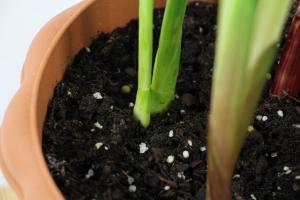Introduction
Blueberries are a wonderful addition to any garden, but not everyone has a big yard or garden plot to grow them in. Luckily, blueberry plants can be grown in pots, making them an ideal option for those who have limited space. In this article, we will discuss how to plant and care for blueberry plants in pots.
Choosing a Container
When choosing a container for your blueberry plant, it's important to select one that is large enough to accommodate the plant's roots. A container that is at least 16 inches in diameter and 18 inches deep is recommended. It's also crucial to ensure that the container has adequate drainage holes to prevent waterlogging, which can lead to root rot.
Soil and Fertilizer
Blueberry plants prefer acidic soil with a pH level between 4.5 and 5.5. Purchase a potting mix specifically formulated for acid-loving plants or create your own mix by combining peat moss, perlite, and composted pine bark. Fertilize your blueberry plant with an acid-based fertilizer every two weeks during the growing season to promote healthy growth and fruit production.
Watering
Blueberry plants require consistent moisture, especially during the growing season. Water your plant regularly, ensuring that the soil is evenly moist but not waterlogged. If the soil becomes too dry, the plant's leaves may turn brown and fall off. Avoid watering the plant from above, as this can increase the risk of disease. Instead, use a watering can or drip irrigation system to water directly at the plant's base.
Light and Temperature
Blueberry plants require full sun to produce fruit, so choose a location for your container where it will receive at least six hours of direct sunlight per day. Keep in mind that blueberries also require cold temperatures during the winter months to break dormancy and produce a good crop. If you live in a region with mild winters, consider placing your blueberry plant in a cooler area of your home during the winter months, such as a basement or garage.
Pest and Disease Control
Blueberry plants can be susceptible to a variety of pests and diseases, including mites, aphids, and powdery mildew. To prevent infestations, inspect your plant regularly for signs of pests or disease, such as curled leaves or discoloration. If you notice any issues, treat your plant with an organic insecticide or fungicide immediately.
Conclusion
Growing blueberry plants in pots is a practical and rewarding way to enjoy fresh fruit even if you don't have a large garden plot. By following these tips for planting and caring for your blueberry plant, you can enjoy a bountiful harvest of sweet, juicy berries in no time.

 how many times do yo...
how many times do yo... how many planted tre...
how many planted tre... how many pine trees ...
how many pine trees ... how many pecan trees...
how many pecan trees... how many plants comp...
how many plants comp... how many plants can ...
how many plants can ... how many plants and ...
how many plants and ... how many pepper plan...
how many pepper plan...
































